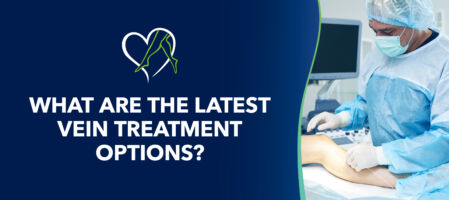
Center for Vein Restoration offers the latest advancements in treatment for problem veins. These cutting-edge, minimally invasive outpatient procedures can rid you of the pain, swelling, and embarrassment of varicose veins once and for all with minimal to no downtime.
Chronic venous insufficiency (CVI), a condition characterized by impaired blood circulation, is widespread in the U.S. As per the National Library of Medicine (NIH), an estimated six to seven million adults in the country suffer from CVI. This condition presents as swollen, achy, heavy-feeling legs, varicose veins, and skin changes, and if not addressed timely, CVI can lead to skin ulcers and blood clots.
Fortunately, today’s outpatient vein treatments take an hour or less and are safe, effective, and painless. Continue reading to learn about the latest vein treatments offered at your local Center for Vein Restoration (CVR).
Leg veins are equipped with tiny valves that propel deoxygenated blood toward the heart. A variety of factors, from genetic predisposition to lifestyle habits, can weaken these valves, resulting in a condition known as venous reflux. This vein condition allows blood to flow backward and accumulate in the veins, leading to edema (leg swelling), pain, cramping, itching, and other discomforting symptoms.
Conservative methods can help reduce chronic venous insufficiency symptoms, but vein treatment procedures are necessary to reverse varicose veins and other signs of CVI. Your vein specialist may recommend these lifestyle changes in addition to treatment:
Wear compression stockings: Available in different strengths and lengths, compression stockings gently squeeze the veins so blood flows smoothly. They are recommended if you need to sit or stand for long periods.
Elevate your legs: Prop up your legs three times a day for about 30 minutes to drain blood from the legs to the heart. The legs-up-the-wall yoga pose is another excellent way to circulate blood from your legs back up toward your heart. According to the Clevland Clinic, the pose, called viparita karani, provides the benefits of inversion without stressing or straining the neck and head. With the torso and head lying flat on the ground, the legs are inverted up a wall. This relaxing pose can reduce swelling by returning bodily fluids stored in the legs back into circulation.
Change your diet: Shedding pounds lifts the excess strain on your veins. Eat a vein-friendly diet of fruits, vegetables, and fiber-rich foods. Cut out salt, which makes you retain water and promotes swelling.
Exercise more: Gentle, low-aerobic exercises such as walking and biking work the calf muscles, which in turn helps push blood through the veins.
Historically, treating varicose veins involved an invasive procedure requiring a lengthy hospital stay. Fortunately, today’s vein treatments have significantly evolved and improved. Minimally invasive procedures are completed on an outpatient basis, allowing you to return to your normal routines immediately with few restrictions and providing a sense of ease and comfort.
If you’re considering undergoing vein treatment, your vein doctor will customize a treatment plan for you, starting with conservative therapies such as the following:
Sclerotherapy: Sclerotherapy is considered the standard treatment for spider veins and smaller varicose veins. During the procedure, the doctor injects a safe, saline-based solution into the vein. The sclerosant irritates and collapses the vein wall, eventually being absorbed by the body.
Thermal ablation: Thermal ablation eliminates the diseased vein using heat from laser or high-frequency radio waves.
Ambulatory phlebectomy: Large veins close to the skin’s surface are treated using ambulatory phlebectomy. The swollen vein is removed via two tiny incisions in the skin.
In addition to these popular vein treatments, newer therapies have emerged over the last few years that are highly effective:
VenaSeal: The vein specialist will inject a proprietary medical adhesive to seal and shut the diseased vein. VenaSeal avoids applying heat, which can be uncomfortable for some patients. No anesthesia is needed.
Varithena: A medicated microfoam is gently injected via a catheter, sealing the vein and causing it to collapse. Blood diverts to nearby healthy veins.
ClariVein: ClariVein involves using a mechanochemical device that administers a sclerosant while a tiny rotating tip moves through the vein to destroy it.
Most of these procedures require only local anesthetic, and patients can drive themselves home from the appointment. Recovery is brief, with only minor restrictions. You may be asked to wear compression stockings to promote healing and circulation. While strenuous exercise should be avoided for a few weeks afterward, walking is encouraged.
While chronic venous insufficiency may not be life-threatening, its impact on quality of life can be profound. Early intervention is key to preventing complications like venous ulcers and blood clots.
Thanks to advancements in outpatient vein treatments, the days of invasive surgery and lengthy hospital stays are a thing of the past! Today, individuals have access to a range of minimally invasive options, each promising safe, effective, and virtually painless relief from the symptoms of CVI.
Center for Vein Restoration (CVR), America’s largest physician-led vein center, has offices nationwide. All vein clinics are staffed by board-certified physicians with years of experience treating all stages of vein disease using state-of-the-art, office-based procedures.
Led by board-certified physicians in all CVR locations, individuals can embark on a journey toward healthier, happier legs. Don't let CVI hold you back—explore your options and reclaim the freedom to live your life fully—without the burden of vein-related discomfort.
Call 240-965-3915 to speak to a Patient Services Representative or schedule your consultation online at a CVR near you today.
CVR accepts many insurances, including Aetna, Amerigroup, Anthem, Blue Cross/Blue Shield, Cigna, MultiPlan, Medicaid, Medicare, and more.
